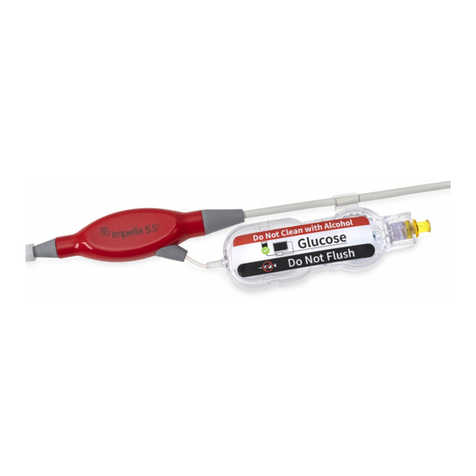
User Manual
4. Assess the anastomosis for hemostasis.
5. Attach a standard 6 Fr introducer to the distal end of the graft.
6. Advance a diagnostic catheter (Abiomed recommends a 6 Fr AL1 or
Multipurpose without side holes or 4–5 Fr pigtail with or without side
holes) over a diagnostic 0.035 inch or 0.038 inch guidewire into the left
ventricle.
7. Remove the diagnostic guidewire and exchange it for the supplied 0.018
inch placement guidewire.
8. Tighten the vessel loops to control bleeding and remove the 6 Fr
introducer.
9. Moisten the Impella 5.5 Catheter and push one of the silicone plugs onto
the catheter shaft adjacent to the Impella 5.5 Catheter motor.
10. Backload the Impella 5.5 Catheter onto the 0.018 inch guidewire (as
described in the steps in previous step 11).
11. With the graft held at the base, place the Impella 5.5 Catheter into the
open end of the graft up to the level of the silicone plug.
12. Secure umbilical tape around the silicone plug.
13. Loosen both vessel loops and advance the Impella 5.5 Catheter along
the guidewire into the left ventricle until it is properly positioned.
To prevent device failure, do not start the Impella 5.5 Catheter until the
placement guidewire has been removed.
Do NOT remove the Impella 5.5 Catheter over the length of the
placement guidewire.
14. Remove the guidewire.
15. Place a soft-jawed clamp at the anastomosis and remove the silicone
plug.
16. Trim any excess graft and slide the repositioning sheath into position.
17. Using a heavy silk tie or umbilical tape, secure the graft around the blue
hub of the repositioning sheath.
18. Close the wound over the trimmed graft with the end of the blue suture
hub clearly visible. The steering catheter for the Impella 5.5 can be
manipulated if needed by unsecuring the repositioning unit and moving
the catheter in or out.
19. If there is slack in the catheter, remove the excess slack. Verify placement
with fluoroscopy and with the placement signal. If the Impella 5.5
Catheter advances too far into the left ventricle and the controller
displays a ventricular waveform rather than an aortic waveform, follow
steps a-c below.
a) Pull the catheter back until an aortic waveform is present on the
placement screen.
b) When the aortic waveform is present, pull the catheter back an
additional 3cm for Impella 5.5 with SmartAssist. (The distance
between adjacent markings on the catheter is 1 cm.)
c) The catheter should now be positioned correctly.
20. Attach the anticontamination sleeve to the blue suture hub. Lock the
anchoring ring in place by turning it clockwise. Secure the catheter
shaft in place by tightening the Tuohy-Borst. Extend the sterile sleeve to
maximum length and secure the end closest to the red Impella®plug by
tightening the anchoring ring.
DIRECT AORTIC INSERTION
NOTE – Proper surgical procedures and techniques are the
responsibility of the medical professional. The described
procedure is furnished for information purposes only. Each
physician must evaluate the appropriateness of the procedure
based on his or her medical training and experience, the type of
procedure, and the type of systems used.
Avoid manual compression of the inlet, outlet, or sensor areas of the
cannula assembly.
Do
NOT
kink or clamp the Impella Catheter with anything other than a soft
jaw vascular clamp. Do
NOT
kink or clamp the peel-away introducer.
Handle with care. The Impella 5.5 Catheter can be damaged during
removal from packaging, preparation, insertion, and removal. Do
NOT
bend, pull, or place excess pressure on the catheter or mechanical
components at any time.
An incision larger than 6 mm may allow the front plug to advance into
the aorta.
The Impella 5.5 Catheter is surgically inserted when there is access to the
ascending aorta through a sternotomy or thoracotomy. Transesophageal
echocardiography (TEE) is required to guide placement.
INSERTION PREPARATION
When using a pigtail diagnostic catheter with side holes, ensure that the
guidewire exits the end of the catheter and not the side hole. To do so,
magnify the area one to two times as the guidewire begins to exit the pigtail.
1. Using the supplied sterile incision template for positioning, place a
sidebiter clamp on the aorta at least 7 cm above the valve plane. An
incision too close to the aortic valve annulus could result in the catheter
outlet area in the graft rather than the aorta.
2. Make an incision (or punch) no larger than 6 mm at the insertion site on
the ascending aorta. The incision must be ≤ 6 mm in length to prevent
the front silicone plug from advancing into the aorta through the incision.
3. Attach the Dacron®vascular graft (10 mm x 15 cm) to the aorta using the
standard end-to-side anastomosis.
4. Administer heparin and achieve ACT of at least 250 seconds. Note:
Maintaining ACT at or above 250 seconds will help prevent a thrombus
from entering the catheter and causing a sudden stop on startup.
*If the patient is receiving a GP IIb-IIIa inhibitor, the Impella 5.5 Catheter
can be inserted when ACT is 200 or above.
5. When the anastomosis is complete, place a clamp at the distal end of the
graft and then release the proximal clamp at the base of the graft. Examine
the suture line for leaks and reclamp the graft at the base.
6. Moisten the Impella 5.5 Catheter and push both silicone plugs up against
the motor housing as shown below.
Impella 5.5 Catheter with Silicone Plugs
7. With the graft clamped at the base, place the Impella 5.5 Catheter into
the open end of the graft up to the level of the rear plug.
8. When the catheter is in position, secure a tourniquet around the rear
silicone plug. Tighten the tourniquet sufficiently to control bleeding
around the rear plug while still allowing the catheter to slide through the
plug.
8


































